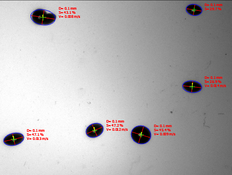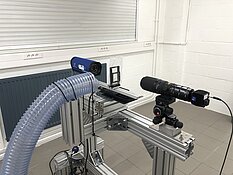Metrology
Optical metrology

The PLEX platform shares its resources with the national platform MéOL (Métrologie Optique de Lille). MéOL is a national center of expertise accredited by the CNRS in the field of optical metrology applied to fluid mechanics, combustion and atmospheric physics and chemistry. For turbulence, PLEX shares with MéOL the optical metrology tools for fluid mechanics that are the particles image/particle tracking velocimetry methods (PIV/PTV).
PIV/PTV Equipments
Whether in liquids or gases, the equipment available at PLEX can cover regions of interest in fluids from cm² to m² at acquisition frequencies up to 150 kHz, allowing the measurement of different spatial and temporal scales, and a monitoring of turbulence structures. This wide measurement range is obtained thanks to a large variety of lasers and cameras that can be combined to realize complex configurations.
Lasers
Features:
- Dual cavity flashlamps pumped
- Energy of 150 mJ/pulse/cavity
- Maximum acquisition rate of 10 Hz
- Good beam quality with M2 of 12
Features:
- Dual cavity flashlamps pumped
- Energy of 250 mJ/pulse/cavity
- Maximum acquisition rate of 10 Hz
- Very good beam quality with supergaussian beam shape and low M2 of 1.2
Features:
- Dual cavity diodes diodes
- Energy of 25 mJ/pulse/cavity (reduce above 1kHz)
- Range of acquisition rate of 0.1 to 10 kHz
- Good beam quality with M2 of 20
Features:
- Single cavity pumped by diode
- Energy of 0.75 mJ/pulse (reduce above 150kHz)
- Range of acquisition rate of 1Hz to 500 kHz
- Very good beam quality with M2 of 1.4
Cameras
Features:
- CMOS cooled sensor with 2560 x 2160 pixels coded over 16 bits
- Pixels of 6.5 µm, sensor size of 16.6 x 14 mm
- 25 frame/s in double frame mode and 50 frame/s in simple frame
- Minimal interframe time of 120 ns
Features:
- CMOS cooled sensor with 2440 x 2040 pixels coded over 12 bits
- Pixels size of 2.7 µm, sensor size of XX mm
- 41 frame/s in double frame mode and 83 frame/s in single frame mode
- Minimal interframe time of 300 ns
Features:
- CMOS cooled sensor with 2560 x 1600 pixels coded over 12 bits
- Pixels size of 10 µm sensor size of 25.6 x 16 mm
- 400 frame/s in double frame mode and 800 frame/s in single frame mode
- 12 Go of internal memory (2000 images at full resolution)
Features:
- CMOS cooled sensor with 2048 x 1920 pixels coded over 12 bits
- Pixels size of 13.5 µm sensor size of 27.6 x 26.3 mm
- 3300 frame/s in double frame mode and 6600 frame/s in single frame mode
- 144 Go of internal memory (25000 frames at full resolution)
- Minimal interframe time of 1 µs
PIV/PTV expertise
The LMFL laboratory, formerly LML (Laboratoire de Mécanique de Lille) was one of the first laboratories in France to develop PIV in the 1990s. The PLEX platform benefits from this past and present expertise to propose experiments in the following fields:
- Complex assembly : turbomachinery, large wind tunnels, burners
- Multi-system assembly: large fields with a spatial resolution adapted to the different scales of the turbulence to be measured
- High magnification setup: measurement of friction or turbulent kinetic energy dissipation
- Handling of laser beams to generate large lightsheets and/or measurement volumes
- Optimization and characterization of PIV measurement noise
- Synchronization and measurement of other physical quantities, phase reconstruction
Shadowgraphy particles characterization
This measurement system allows to evaluate the size, concentration and speed of particles by shadowgraphy (visualization of the shadow formed by the particles on the camera image). This system is able to measure:
- Size, shape, orientation, of particles
- Velocity and mass flow from double frame images
- Measurement range from 10 µm to several millimeters
Others metrology equipments
Hot wire anemometry
The platform has several hot-wire systems, including a carriage to allows measurements at different positions in the test section of the boundary layer wind tunnel. The systems support up to 8 independent channels at 50kHz acquisition frequency.
Pressure measurement
Several micromanometers accurate to 0.1% in the range 0 to 200 Pa are available. They can be equipped with scannivalves to increase the number of channels up to 120 channels.

![[Translate to English:] Organisme financeur [Translate to English:] Accès à l'organisme financeur : l'Europe s'engage en Hauts-de-France](/fileadmin/user_upload/plateforme-experimentale-turbulence/images/logos/europe_HDF.svg)
![[Translate to English:] Organisme financeur [Translate to English:] Accès à l'organisme financeur : Région Hauts-de-France](/fileadmin/user_upload/plateforme-experimentale-turbulence/images/logos/Logo_Re__gion_HDF.svg)
![[Translate to English:] Organisme de tutelle : CNRS [Translate to English:] Accès à l'organisme de tutelle : CNRS](/fileadmin/user_upload/plateforme-experimentale-turbulence/images/logos/logo_CNRS.svg)
![[Translate to English:] Organisme de tutelle : Centrale Lille [Translate to English:] Accès à l'organisme de tutelle : Centrale Lille](/fileadmin/_processed_/3/3/csm_logo_centrale_lille_cf284674ba.png)
![[Translate to English:] Organisme de tutelle : Université de Lille [Translate to English:] Accès à l'organisme de tutelle : Université de Lille](/fileadmin/_processed_/3/c/csm_ULille_logo_2fae4f0874.png)






